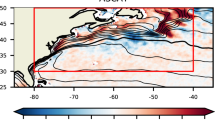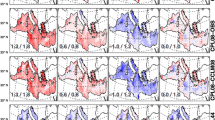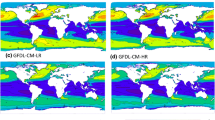Abstract
Annual mean ocean surface heat fluxes have been studied as a function of horizontal resolution in the ECMWF model (cycle 33) and compared with Oberhuber's COADS (1959–1979) based empirical estimates. The model has been run at resolutions of T21, T42, T63 and T106 for 15 months with prescribed monthly varying climatological SST and sea ice. The T42 simulation was extended to 2 years, which enabled us to determine that many differences between the resolution runs were significant and could not be explained by the fact that individual realizations of an ensemble of years can be expected to give different estimates of the annual mean climate state. In addition to systematic differences between the modeled and the observed fluxes, the simulated fields of surface shortwave and longwave radiation showed much more spatial variability than the observed estimates. In the case of the longwave radiation this may be attributable more to deficiencies in the observations than to errors in the model. The modeled latent and sensible heat fields were in better agreement with observations. The primary conclusion concerning the dependence of ocean surface fluxes on resolution is that the T21 simulation differed significantly from the higher resolution runs, especially in the tropics. Although the differences among the three higher resolution simulations were generally small over most of the world ocean, there were local areas with large differences. It appears, therefore, that in relation to ocean surface heat fluxes, a resolution greater than T42 may not be justified for climate model simulations, although the locally large differences found between the higher resolution runs suggest that convergence has not been achieved everywhere even at T106.
Similar content being viewed by others
References
Alexander RC, Mobley RL (1976) Monthly averaged sea surface temperature and ice pack limits on a 1° global grid. Mon Weather Rev 104:143–148
Boer GJ, Laprise R (1984) Some results concerning the effect of horizontal resolution and gravity-wave drag on simulated climate. J Clim 1:789–806
Boyle JS (1993) Sensitivity of dynamical quantities to horizontal resolution for a climate simulation using the ECMWF (cycle 33) model. J Clim (in press)
Boville BA (1991) Sensitivity of simulated climate to model resolution. J Clim 4:469–485
Carissimo BC, Oort AH, Vonder Haar TH (1985) Estimating the meridional energy transports in the atmosphere and ocean. J Phys Oceanogr 15:82–91
Esbensen SK, Kushnir Y (1981) The heat budget of the global ocean: an atlas based on estimates from surface marine observations. Report No 29, Climate Research Institute, Oregon State Univ, Corvallis, Oregon, USA
Gutowski WJ, Gutzler DS, Wang WC (1991) Surface energy balances of three general circulation models: implications for simulating regional climate change. J Clim 4:121–134
Hanawa K, Toba Y (1987) Critical examination of estimation methods of long-term mean air-sea heat and momentum transfers. Ocean-Air interactions 1:79–93
Hsuing J (1985) Estimates of global oceanic meridional heat transport. J Phys Oceanogr 15:1405–1413
Hsuing J (1986) Mean surface energy fluxes of the oceans. J Geophys Res 91:10585–10606
Kiehl JT, Williamson DL (1991) Dependence of cloud amount on horizontal resolution in the National Center for Atmospheric Research community climate model. J Geophys Res 96:10955–10980
Large WG, Pond S (1982) Sensible and latent heat flux measurements over the sea. J Phys Oceanogr 12:464–482
Louis J-F (1979) A parametric model of vertical eddy fluxes in the atmosphere. Boundary-Layer Meteorol 17:187–202
Miller JR, Russell GL, Tsang LC (1983) Annual oceanic heat transports computed from an atmospheric model. Dyn Atmos Oceans 7:95–109
Miller MJ, Beljaars ACM, Palmer TN (1992) The sensitivity of the ECMWF model to the parameterization of evaporation from the tropical oceans. J Clim (in press)
Morcrette J-J (1991) Radiation and cloud radiative properties in the ECMWF operational weather forecast model. J Geophys Res 96:9121–9132
Oberhuber JM (1988) The budgets of heat, buoyancy and turbulent kinetic energy at the surface of the global ocean. Max-Planck-Institute for Meteorology Report Number 15, Hamburg, FRG
Phillips T, Corsetti LC, Grotch SL (1993) The effect of horizontal resolution on moist processes in the ECMWF model. PCMDI Report No 8, Lawrence Livermore National Laboratory, Livermore CA, USA
Planton S, Deque M, Bellevaux C (1991) Validation of an annual cycle simulation with a T42-L20 GCM. Clim Dyn 5:189–200
Randall DA, Cess RD, Blancher JP, Boer GJ, Dazlich DA, Del Genio AD, Deque M, Dymnikov V, Galin V, Ghan SJ, Lacis AA, Le Treut H, Li Z-X, Liang XZ, McAvaney BJ, Meleshko VP, Mitchell JFB, Morcrette J-J, Potter GL, Rikus L, Roeckner E, Royer JF, Schlese U, Sheinin DA, Slingo J, Sokolov AP, Taylor KE, Washington WM, Wetherald RT, Yagai I, Zhang M-H (1992) Intercomparison and interpretation of surface energy fluxes in atmospheric general circulation models. J Geophys Res 97:3711–3725
Rossow WB, Schiffer RA (1991) ISCCP Cloud data products. Bull Am Meteorol Soc 72:1–19
Simonot JY, Le Treut H (1987) Surface heat fluxes from a numerical weather prediction system. Clim Dyn 2:11–28
Slingo JM (1982) A study of the Earth's radiation budget using a general circulation model. Quart J R Meteorol Soc 108:379–405
Stone P, Risby JS (1990) On the limitations of general circulation climate models. Geophys Res Let 17:2173–2176
Tibaldi S, Palmer TN, Brankovic C, Cubasch U (1990) Extended-range predictions with ECMWF models: Influence of horizontal resolution on systematic error and forecast skill. Quart J R Meteorol Soc 116:835–866
Weare BC (1989) Uncertainties in estimates of surface heat fluxes derived from marine reports over the tropical and subtropical oceans. Tellus 41A:357–370
Weare BC, Strub PT, Samuel MD (1981) Annual mean surface heat fluxes in the tropical Pacific Ocean. J Phys Oceanogr 11:705–717
Woodruff SD, Slutz RJ, Jenne RL, Steurer PM (1987) A comprehensive ocean-atmosphere data set. Bull Am Meteorol Soc 68:1239–1250
Wright PB (1988) An atlas based on the ‘CORDS’ data set: Fields of mean wind, cloudiness and humidity at the surface of the global ocean. Max-Planck-Institute for Meteorology Report Number 14, Hamburg, FRG
Author information
Authors and Affiliations
Rights and permissions
About this article
Cite this article
Gleckler, P.J., Taylor, K.E. The effect of horizontal resolution on ocean surface heat fluxes in the ECMWF model. Climate Dynamics 9, 17–32 (1993). https://doi.org/10.1007/BF00208011
Received:
Accepted:
Issue Date:
DOI: https://doi.org/10.1007/BF00208011




